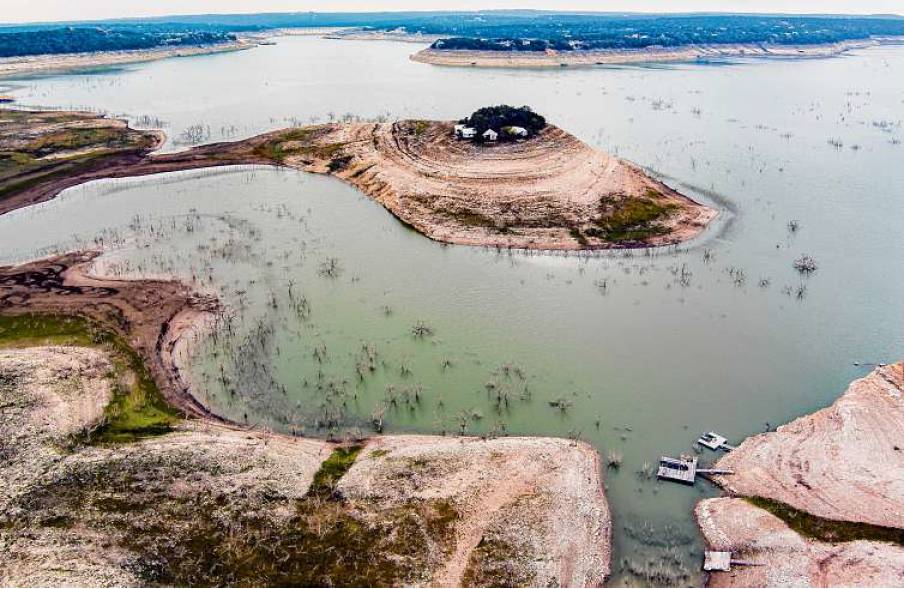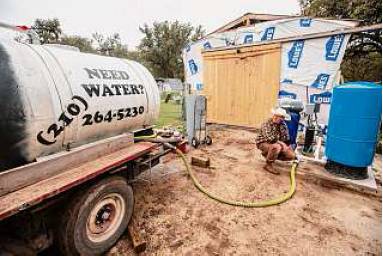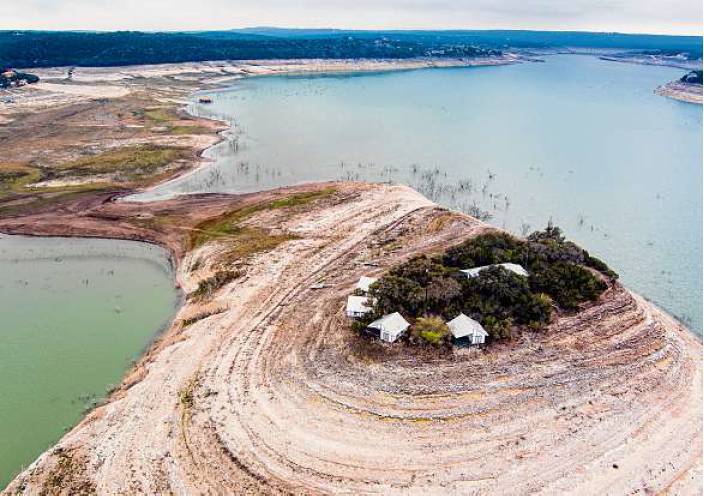Waters keep on dropping
As Medina Lake dries up, nearby wells run low, too
By Elena Bruess STAFF WRITER
When David Cahill’s three wells ran out of water last year, he wasn’t surprised.
It had been a long time coming, and he knew eventually he would have to dig another, deeper well on his property. Still, the final price — just under $30,000 — he didn’t expect.
In the community of Lake-hills, just outside Medina Lake west of San Antonio, Cahill is far from the only one with a recently dried-up well. Most of his neighbors have lost water, too, but his is one of the only households that can afford to go into debt to dig a new one.
“I’ve been delivering water to six neighbors on my street so far,” Cahill said. “My new well won’t ever go dry, so I’ve been helping out where I can. A new well has jumped another $10,000 since I bought mine, and the wait time for one is around nine months now. It’s a big financial impact.”
It’s not just the wells drying up. Medina Lake is the lowest it’s been since 2015. For months, the lake has been sinking lower and lower because of drought and irrigation. The century-old reservoir — which straddles Medina and Bandera counties — was 6.5 percent full late last month, having dropped 33 feet in a year. Lake-view houses look out on jagged white rocks rather than shimmering water, and local businesses, which depend on the lake for financial fuel, are struggling to stay alive.
In Lakehills, however, the situation is even more dire. As Medina Lake shrank last year, groundwater dwindled, too — both starved of rain because of the near-record drought. While the exact connection between the two bodies of water is somewhat unclear, groundwater and surface water in Southwest Texas tend to affect each other greatly.
Most wells are about 100 feet deep, which is not enough to reach the water supply there. Because of this, residents longing for rain are left with two options: dig a new well or buy water.
“With the lake being down, this is a huge loss for the community,” Cahill said. “Not everyone can afford these new expenses, so then what will happen? It’s a bad situation.”
Endless drought
For years, residents around Medina Lake have complained about the extreme variations in lake levels and have accused lake management of letting the water run dry.
The entity tasked with managing the lake, the Bexar-Medina-Atascosa Water Control and Improvement District No. 1, known as the BMA, releases Medina Lake water every year for local farmers to irrigate their land. Last year, however, because of the ongoing drought, the BMA decided to sell only 6,000 acre-feet of water to its customers, rather than the regular 46,000 acre-feet. An acre-foot is about 326,000 gallons.
Still, by the time the BMA was done distributing the water in the fall, the lake lost 20 percent capacity, which is about 50,000 acre-feet of water, according to data from the Texas Water Development Board.
Save Medina Lake, a committee of the Lake Medina Conservation Society, said this is because of the amount of water lost when distributing water for irrigation. The Medina Lake-area residents who make up the committee have worked for years to prevent the lake from drying up, as it did in 2015 and again last year.
Save Medina Lake contends that in order to deliver 6,000 acre-feet, the BMA released 24,000 acre-feet to compensate for water lost — such as through evaporation or seepage — while it’s transported through dirt canals.
To reduce such losses, the BMA has lined 47 of its 312 miles of canals with piping, and it said in a statement that “these improvements will address the areas of large losses, better water conservation and improve delivery time for landowners.”
“I really wish we could get a conversation with the BMA going,” said Michelle Reichle, a member of Save Medina Lake and a real estate agent for the area. “We could just brainstorm how things might go in the future, how we can do things differently.”
In October, the BMA board unanimously took action to stop all water sales until further notice for the 2023 watering season.
“The BMA board understands the hardships the current drought has bestowed on the landowners and BMA district,” a statement reads. “The board is paying close attention to the drought conditions, and should rainfall create additional water availability in Medina Lake, the board will react as quickly as possible.”
Even so, last summer Save Medina Lake sent an official complaint to the state’s environmental regulator, the Texas Commission on Environmental Quality, accusing the BMA of not taking actions called for in its 2013 Drought Contingency Plan. That plan states that when the volume of water in the lake drops to 46,000 acre-feet or less for 30 days, the BMA should initiate a critical water storage stage. But even though Medina Lake reached 46,000 acre-feet May 12, the release of water from it has not been terminated or reduced.
Responding to the complaint in July, the TCEQ said it requires that the BMA have a concrete drought contingency plan, with targeted water use reductions during water shortages, but that it does not have the authority to require organizations to implement their plans.
Because of this, members of Save Medina Lake are planning to challenge those restrictions during the upcoming legislative session.
“It’s still a great place to live,” Reichle said. “I just wish things could be different.”
Running out of water
Currently, the price for 1,000 gallons of water for Lakehills residents is $175, which for most people usually lasts about two weeks. The water is for everything — drinking, showering, cooking, yard work — and can run out fast.
To help out, Cahill sells his water at $125. Still, members of the community might not be able to afford that, either; $250 can be a lot every month, Cahill said.
The price for drilling a new well has gone up, too. Just a few years ago, it was $15,000. Now, it’s nearly tripled. The cost of the materials has gone up, as has the price of diesel, which the contractors need for trucking and for drilling the well. Then the labor itself is at least $20 an hour. PVC pipe, which used to be around $20 a stick, is now around $40 to $50.
“You see people driving around Lakehills with those 5-gallon drums because they’re going to someone’s house to fill up their barrels just to drive back home to put it in buckets so they can flush their toilets or whatever else,” Cahill said. “People just don’t have the resources to do much else.”
He’s doubtful that he’ll see a lot of rain in the new year, either. This winter is forecast to be warm and dry until next fall, when La Niña, a weather phenomenon that results in higher temperatures and less rainfall in Texas, ends and is replaced by El Niño, which makes it wetter and colder.
The hope is a repeat of 2015. The levels were at 3 percent at the beginning of the year, but after weeks of rain in the spring, they reached over 70 percent by that June.
Nevertheless, some residents had thought last year would have more rain in the winter, but since that didn’t happen, they are feeling less hopeful for the new year’s forecast.
In the meantime, no one around Medina Lake, including the farmers who depend on it for irrigation, is getting any water from it this year. And the lake will continue to dwindle to an even smaller puddle.
For Reichle, a die-hard advocate for Medina Lake, it’s the same story again and again: a tale of water, drought, irrigation and the BMA.
“I mean, it’s been like this all year,” she said. “It’s just worse now.”
Elena Bruess writes for the Express-News through Report for
America, a national service program that places journalists in local newsrooms. ReportforAmerica.org . elena.bruess@express-news.net


